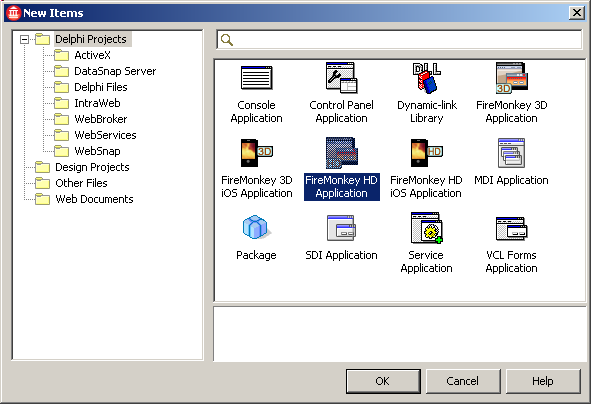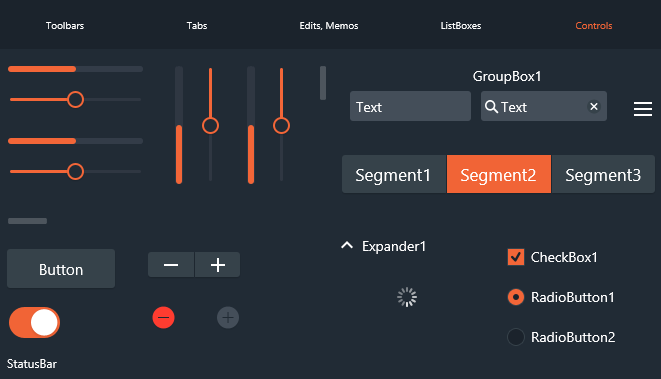With introduction of Metropolis UI styles the importance of the FMX.Types.TStyledControl.StyleLookup property seriously increases. The reason of this is that Metropolis UI styles contain lots of styles for buttons, panes, lists, and other control elements. Each control has the default style, but you can change this default style to any style accessible for the class of a control. The StyleLookup property can be used to specify such additional style. In StyleLookup you can select the name of an additional style for the control like searchbuttontext from the general style loaded into the TStyleBook or from the default style for the used platform. Recoil swf to mp4 converter crack torrent online.


For the convenience of usage of the StyleLookup property in the design mode, the drop-down list showing all applicable to the control styles is provided. This list shows the preview of styles. Now it is easy to select a style for a control in the StyleLookup property. Creating custom styles for controls, in order that your styles appear in the StyleLookup list, you should use the name of a control class in your style name.
For example, in order that the name of a style for TButton appears in the StyleLookup list, you should add into the style name the 'button' class name (for example 'mybutton', 'specialbutton'). If you create a style for TListBox, then you should add the 'listbox' class name (for example 'mylistbox', 'speciallistbox').
FireMonkey Multiplatform Style Templates and VCL Styles. HQ Professional Graphics with Modern Trends. MultiPlatform FM Styles.
For example, the StyleLookup list for TButton, when the Metropolis UI Black style is selected for TStyleBook, can look like this: StyleSettings Property. Delphi XE3 introduces the new FMX.Types.TTextControl.StyledSettings property of the TStyledSettings type: TStyledSetting = (ssFamily, ssSize, ssStyle, ssFontColor, ssOther); TStyledSettings = set of TStyledSetting; This property is used in FMX controls (descending from TTextControl) as TButton, TSpeedButton, TCheckBox, and others. This property provides possibility to switch ON and OFF properties of the font used to draw a control text.
The reason is that some styles, for example in Metropolis IU styles, define the font name and size. If you do not want to use for a control text the font properties defined in a style, then you can switch OFF the following (defined in the style) properties of the font: ssFamily - font name, ssSize - font size, ssStyle - font style, ssFontColor - font color, ssOther - text position. The following figure shows TButton with ssSize turned OFF (Button1) and ON (Button2) Switching ON and OFF Stylization of the Form Border. Akt na unichtozhenie dokumentov s istekshim srokom hraneniya blank ukraine. Delphi XE3 introduces the new Boolean property FMX.Forms.TForm.EnableBorderStyling. Using this property, you can implement stylization of a form border. In Windows application you can apply styles to all border elements including system buttons.
In Mac OS applications you can customize only the background of the form’s caption — you cannot customize system buttons. This is the common tendency to Mac OS applications. By default, EnableBorderStyling = True; that is styling is applied to a form. Notice that not all styles contain styles for a form border; in this case the system border is used. The following figure shows how the form border looks in the Jet style under Mac OS: The following figure shows how the form border looks in the Jet style under Windows: Stylization of the Form’s Main Menu. In Delphi XE3, you can organize the form’s main menu using the TMenuBar control or TMainMenu component.
TMenuBar You can use this control to create the main menu in the client part of a form. Notice that under Mac OS, the created main menu does not appear on the Mac OS menu bar - it always appears in the client part of the form. The following figure shows usage of TMenuBar with the Transparent style under Windows (it looks rather spectacular with half-transparent graphics): TMainMenu When you use TMainMenu, the main menu is created in the nonclient part of the form under Windows and under Mac OS the created main menu appears on the Mac OS menu bar. Under Windows, if a style defines graphics for a form’s border, then the main menu and all its sub-menus are stylized. If the style does not define the form’s border or you have set, EnableBorderStyling = False, then the main menu is system (the same as the border). The following figure shows usage of TMainMenu with the Jet style under Windows: The following figure shows usage of TMainMenu with the Jet style under Mac OS: Support of the Retina Display on Mac Book Pro. Apple launches the third generation of MacBook Pro with the Retina display.